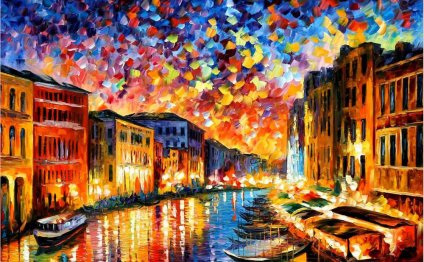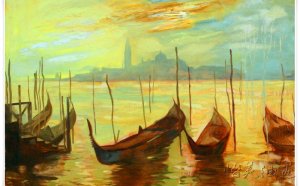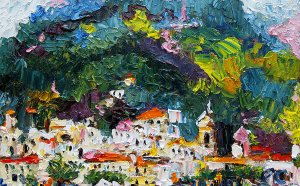
Oil Paintings Italy
The oil painting technique was to become dominant in the 15th and 16th centuries, it has remained as the artists favorite medium only being challenged in the latter years of the twentieth century by the advent of acrylic paint.
Artists working in tempera found that their colours lacked the covering power of oils while the fresco painter was unable to make alterations to his work. Oil provided a versatile medium in which the artist was allowed the freedom to change the composition of his painting.
Because the colour saturation of the paint was enhanced by the use of oil, no other medium could reproduce it's range of both transparency and opacity.
The methods of applying oil paints to a surface have become varied in the extreme; from the traditional use of brushes and pallete knives; to the use of hands and feet; or the splattering of paint direct from tubes and cans; in the modern era it seems that just about anything is used by artists to achieve the desired effect.
During the early renaissance period oil painting was used first by the Netherlandish painters and was eventually taken up by their counterparts in Italy.
The Northern painters preparation was consistent, they used oak panels (or other timbers) with smooth, white chalk grounds. A detailed under drawing was then added and usually made none absorbent by the application of a drying oil.
15th Century Oil Technique circa:-1436. (Northern Art)
The use of canvas as a support for oil paints allowed for easier transport of larger compositions, canvas is far lighter that oak panels, also a painting executed on canvas can be rolled up and transported more easily than wooden panels. Canvas became prominent in the Italian renaissance and it was widely used particularly in Venice. Venice was a wealthy trading port and, in the many workshops within the city, produced sails made from linen and other fabrics. In fine art linen is still considered to be the finest support for oil painting. Later examples of oil paintings from the Venetian painters include works by Veronese, Tintoretto and, as in the painting below, Titian.
16th Century Oil Technique circa:-1562. (Italian Art)
Of course the methods of applying oil paint are many and varied, the oil painting techniques on this site generalize on two particular examples from the renaissance era. It would not be possible to give a full account of the complex nature of the medium over subsequent centuries, or the modern applications of oil within the context of this site.
YOU MIGHT ALSO LIKE



Share this Post
Related posts
Italian oil Paintings
Fresco painting has been around for a very long time, examples of fresco painting techniques date back to at least 1500 BC…
Read MoreOil Paintings of Italy
Jan Van Eyck is the Flemish painter often credited as the first master, or even the inventor of oil painting. That he was…
Read More





